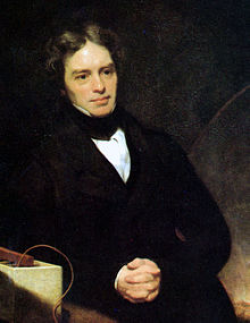Michael Faraday

- Born
- 22 September 1792
- Died
- 25 August 1867 (age 74)
The son of a blacksmith, Michael Faraday was certainly not from the sort of gentlemanly background that the vast majority of his scientific contemporaries came from. He received little formal education and would train as an apprentice in a bookshop. But his work did give him access to a vital scientific resource - books. Reading through the library in George Riebau’s shop, Faraday developed an interest in science, especially questions surrounding electricity, and soon after he was attending lectures at the place where he would make his name, the Royal Institution.
After the Chemical Assistant got the sack the hugely eminent scientist Humphrey Davy asked Faraday to join the Royal Institution as their replacement in 1813. This was one of the best jobs for a young would-be scientist to land in the early 19th century science.
Davy was essentially the first rock star scientist. In fact, the scientific lectures of the Royal Institution proved so incredibly popular that a new form of traffic management was invented to cope with the demand. The first one way street in Britain was Albemarle Street. It was made so to deal with the amount of traffic Davy’s lectures would generate.
Faraday would take a lot from his patron and mentor Davy. Not least the scientific training to go on to have one of the most impressive research careers science has ever seen. From establishing the basic concepts of the electromagnetic field to discovering benzene to inventing an early form of the Bunsen burner, Faraday has left a huge mark on science. Yet his work was not only in research as he was also a pioneer in communicating scientific knowledge to the public.
The Christmas Lectures at the Royal Institution, which still continue to this day, were started by Faraday. He held it was of the utmost importance that science was not seen to be an incomprehensible force beyond that of the layperson and held it to be a duty to educate, if not inspire, the public through his lectures.
From exceptionally humble beginnings Faraday would rise to become perhaps the most famous scientist of his age. Yet in a sense what was more impressive was how despite his success he managed to remain so modest. He would reject the Presidency of the Royal Society twice, as well as refuse a Knighthood. For him to pursue worldly riches and rewards was in contradiction to Christian teachings. So not only does the life of Faraday teach us a lesson in humility, but it also displays how across much of the 19th century there was no inherent conflict between religion and science.
Indeed, from the time of the Scientific Revolution discovering the laws of nature was thought to bring us closer to God. This idea must have been a powerful motivation for Faraday helping him gather the tenacity needed to at first infiltrate and then lead within the elite world of 19th century British science.



